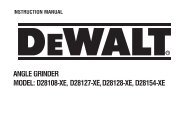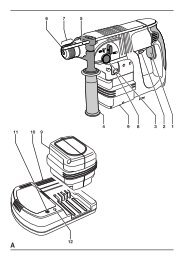Create successful ePaper yourself
Turn your PDF publications into a flip-book with our unique Google optimized e-Paper software.
• Loosen the screw for the arbor collar (44) and rotate the blade (45) a<br />
quarter turn.<br />
• Retighten the screw and check to see if the blade has any wobble.<br />
• Repeat these steps until the blade wobble has been eliminated.<br />
Adjustments for mitre saw mode<br />
Your mitre saw was accurately adjusted at the factory. If readjustment<br />
due to shipping and handling or any other reason is required, follow the<br />
steps below to adjust your saw. Once made, these adjustments should<br />
remain accurate.<br />
Checking and adjusting the blade to the fence (fi g. G1 - G4)<br />
• Release the mitre lever (10) and depress the mitre latch (9) to<br />
release the mitre arm (11).<br />
• Swing the mitre arm until the latch locates it at the 0° mitre position.<br />
Do not tighten the lever.<br />
• Pull down the head until the blade just enters the saw kerf (48).<br />
• Place a square (49) against the left side (13) of the fence and blade (45)<br />
(fi g. G3).<br />
Do not touch the tips of the blade teeth with the square.<br />
• If adjustment is required, proceed as follows:<br />
• Loosen the screws (50) and move the scale/mitre arm assembly left<br />
or right until the blade is at 90° to the fence as measured with the<br />
square.<br />
• Retighten the screws (50). Pay no attention to the reading of the<br />
mitre pointer at this point.<br />
Adjusting the mitre pointer (fi g. G1, G2 & H)<br />
• Release the mitre lever (10) and depress the mitre latch (9) to<br />
release the mitre arm (11).<br />
• Move the mitre arm to set the mitre pointer (51) to the zero position,<br />
as shown in fi g. H.<br />
• With the mitre lever loose, allow the mitre latch to snap into place as<br />
you rotate the mitre arm past zero.<br />
• Observe the pointer (51) and mitre scale (12). If the pointer does not<br />
indicate exactly zero, loosen the screw (52), move the pointer to read<br />
0° and tighten the screw.<br />
Mitre lock/detent rod adjustment (fi g. I)<br />
If the base of the saw can be moved while the mitre lever (10) is locked,<br />
the mitre lock/detent rod (53) must be adjusted.<br />
• Unlock the mitre lever (10).<br />
• Fully tighten the mitre lock/detent rod (53) using a screwdriver (54).<br />
Then loosen the rod a quarter of a turn.<br />
• Check that the table does not move when the lever (10) is locked at<br />
a random (not preset) angle.<br />
Checking and adjusting the blade to the table (fi g. J1 - J4)<br />
• Loosen the bevel clamp handle (15).<br />
• Press the saw head to the right to ensure it is fully vertical and<br />
tighten the bevel clamp handle.<br />
• Pull down the head until the blade just enters the saw kerf (48).<br />
• Place a set square (49) on the table and up against the blade (45)<br />
(fi g. J2).<br />
Do not touch the tips of the blade teeth with the square.<br />
• If adjustment is required, proceed as follows:<br />
• Loosen the bevel clamp handle (15) and turn the vertical position<br />
adjustment stop screw (55) in or out until the blade is at 90° to the<br />
table as measured with the square.<br />
ENGLISH<br />
• If the bevel pointer (56) does not indicate zero on the bevel scale<br />
(14), loosen the screw (57) that secures the pointer and move the<br />
pointer as necessary.<br />
Adjusting the fence (fi g. K1 & K2)<br />
The upper part of the left side of the fence can be adjusted to the left to<br />
provide clearance, allowing the saw to bevel to a full 45° left. To adjust<br />
the fence (13):<br />
• Loosen the plastic knob (58) and slide the fence to the left.<br />
• Make a dry run with the saw switched off and check for clearance.<br />
Adjust the fence to be as close to the blade as practical to provide<br />
maximum workpiece support, without interfering with the up and<br />
down movement of the arm.<br />
• Tighten the knob securely.<br />
The guide groove (59) can become clogged with sawdust.<br />
Use a stick or some low pressure air to clear the guide<br />
groove.<br />
The moveable part of the right side of the fence can be adjusted to<br />
provide maximum support of the workpiece near the blade,<br />
while allowing the saw to bevel to a full 45° left. The sliding distance is<br />
limited by stops in both directions. To adjust the fence (6):<br />
• Loosen the wingnut (60) to release the fence (6).<br />
• Slide the fence to the left.<br />
• Make a dry run with the saw switched off and check for clearance.<br />
Adjust the fence to be as close to the blade as practical to provide<br />
maximum workpiece support, without interfering with the up and<br />
down movement of the arm.<br />
• Tighten the wingnut (60) to secure the fence in place.<br />
Checking and adjusting the bevel angle (fi g. A1, A2 & J5)<br />
• Loosen the left side fence clamping knob (58) and slide the upper<br />
part of the left side fence to the left as far as it will go.<br />
• Loosen the bevel clamp handle (15) and move the saw head to the<br />
left. This is the 45° bevel position.<br />
• If adjustment is required, proceed as follows:<br />
• Turn the stopscrew (61) in or out as necessary until the pointer (56)<br />
indicates 45°.<br />
While performing this adjustment, it is advisable to take the<br />
weight of the saw head by holding it. This will make it easier<br />
to turn the adjustment screw.<br />
Rail guide adjustment (fi g. L)<br />
• Regularly check the rails for clearance.<br />
• To reduce clearance, gradually rotate the set screw (62) clockwise<br />
while sliding the saw head back and forth.<br />
Adjustments for saw bench mode<br />
Changing from mitre saw to saw bench mode (fi g. A1 & A2)<br />
• Put the blade into 0° cross-cut position with the mitre lever (10)<br />
secured (fi g. A1).<br />
• Lock the rail lock knob (17) with the saw head in the rear position.<br />
• Press the head lock-up release lever (3) to lower the head and<br />
depress the lock down pin (16).<br />
• Fit the parallel fence (22) as described below.<br />
Adjusting the riving knife (fi g. M1 & M2)<br />
The correct position is for the top of the riving knife (20) to be no more<br />
than 2 mm below the highest tooth of the blade and the body of the radius<br />
to be a maximum of 5 mm from the tips of the saw blade teeth (fi g. M1).<br />
33

















